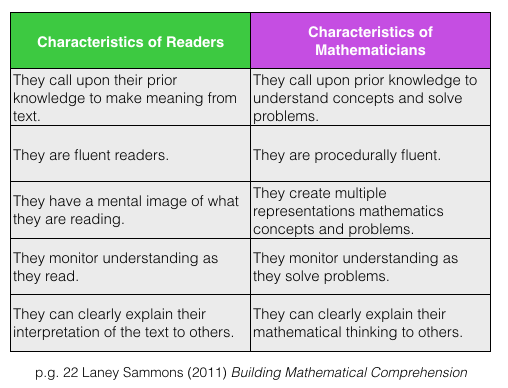|
Friday was the Provincial Professional Development day in our province, BC. I had the pleasure of co-presenting with Lisa Schwartz, Richmond School District's Literacy Consultant. You might be asking yourself why a math educator like myself would be presenting with someone with a literacy background. Well, not only are we friends, but over the years in our discussions about teaching, we have come to realize that their are many commonalities between developing readers and mathematicians. In our presentation we shared many of our favourite children's books and how we have used them for both literacy and mathematical learning intentions. In Laney Sammons book Building Mathematical Comprehension: Using LIteracy Strategies to Make Meaning, she uses a chart to discuss the similarities readers and mathematians share. These similarities are yet another reminder that our habits of mind, or core and curricular competencies, as now called in our revised BC Curriculum, are important! In order to develop as mathematicians or readers, our students need to:
It is this knowledge about the importance of our processes to develop understanding, that is one of the central tenets at the heart of the new curriculum. Our curriculum is no longer solely focused on content. Although, I would argue it never was. The processes in the 2007 BC Math IRP mirror many of the curricular competencies, but through the physical design of the "Know, Understand, Do" (KUD) model, the curricular compentencies have been lifted and made a priority. Using this framework, as well as a belief that learning needs to include all of our children, Lisa and I worked with several children's literature books to create learning intentions for both literacy and numeracy. The following is an example of one of the books I used. Brown Bear, Brown Bear, What Do You See? by Bill Martin Jr. is a classic picture book that students and teachers have enjoyed reading aloud for years. Using the book, we designed learning intentions for all, some and a few, as you can see below. Working with a Kindergarten class, I did an interactive read aloud and engaged with the book prior, during, and after reading to make predictions, ask questions, explore mathematical ideas, and engage in problem solving. Hintz and Smith (2013) describe this process as "mathematizing". Mathematizing is a way of looking at the world through a mathematical lens. Through reading motivating children's literature books, students are inspired to read and write. They are also able to make connections and build their schema in meaningful ways.  The Kindergarten teacher and I were not sure if the students would be able to represent how many animals they saw in the story. When we used the concrete felt animals the students could touch and count, using one-to-one correspondence to count and tell how many (cardinality). Once back at their tables, it was going to be more complex to represent what they were seeing and hearing in the book. We were excited to see the different strategies the students might think of to use. Some used tally marks but without a diagonal line crossing over four vertical lines. A couple students drew pictures, and a few used checkmarks. Their representations provided excellent assessment for learning because we could see the child's sense-making through the images they created. We made note of a few children who were beginning to use numerals to tell information. As well, by reflecting on the emerging tally marks, we knew one of our next steps would be to explicitly teach how we organize tally marks. The representations also provided us a record that we can use for assessment, to compare to later in the year to note any differences and growth. Following this lesson, the students enjoyed reading the story once again and following it up with sequencing the animals in the story. Everyone had fun reading the story aloud as a class, while touching their sequencing strips. This familiar story gave all of the students an opportunity to see themselves as readers. Later in the week, the Kindergarten teacher worked collaboratively with the students to co-create a class book, with a similar pattern. This new, class authored book is now a class favourite. What I was reminded of while planning for this presentation, is that teachers do not have to simply use books with explicit mathematical concepts to explore math concepts. Instead, I believe almost any book could be used because when you dig deep enough, in my experience, math can be found in just about any situation. What favourite books have you used with your young Mathematicians? I am always looking for new ideas. Hintz, A. and Smith, A. Mathematizing Read Alouds in Three Easy Steps. In Reading Teacher. 67(2), May 2013. Sammons, L. (2011). Building mathematical comprehension:. Huntington Beach, CA: Shell Education.
3 Comments
|
About Me
I am a Numeracy Helping Teacher with the Surrey Schools District. Each day I am thankful for being able to work with amazing students and teachers in an area I am passionate about ~ Mathematics! Subscribe:Click the RSS feed button
Archives
October 2018
Categories
All
|




 RSS Feed
RSS Feed
